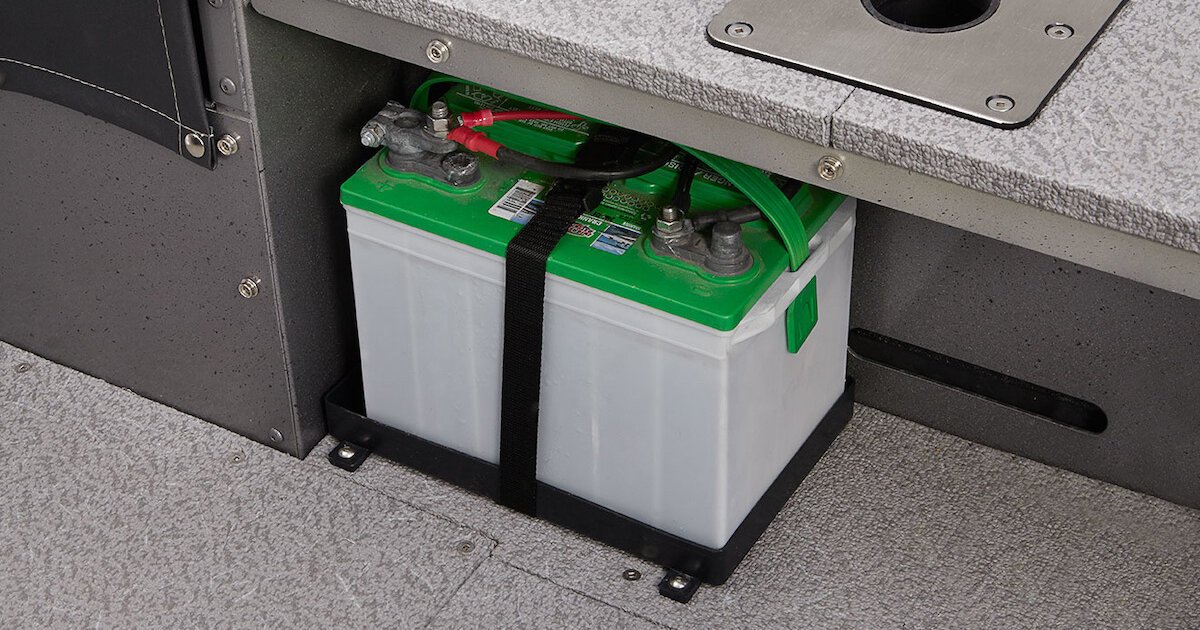Navigating the waters of marine batteries can be a daunting task. With a myriad of options available, making the right choice can be challenging.
Understanding the different types of marine batteries is crucial. It can significantly impact the performance and longevity of your boat’s electrical system.
In this comprehensive guide, we delve into the three main types of marine batteries. These include starting (cranking) batteries, deep cycle batteries, and dual-purpose batteries.
We will explore their unique characteristics, uses, and the factors to consider when choosing the right one for your needs. This guide aims to equip you with the knowledge to make an informed decision.
Whether you’re a seasoned sailor or a novice boater, this article will provide valuable insights. Let’s set sail on this journey of discovery together.

Understanding Marine Batteries and Their Importance
Marine batteries are the lifeblood of any boat’s electrical system. They power everything from the engine starter to the onboard electronics. Without a reliable marine battery, your boating experience can quickly turn sour.
These batteries are specifically designed for the harsh marine environment. They are built to withstand the constant vibrations, temperature fluctuations, and corrosive conditions that are common in boating.
Moreover, marine batteries are designed to deliver power differently than regular batteries. They can provide a quick burst of energy or a steady current over a long period, depending on their type.
Understanding the different types of marine batteries and their unique characteristics is crucial. It can help you choose the right battery that matches your boating needs and preferences.
In the following sections, we will delve deeper into the role of marine batteries in boating. We will also compare them with automotive batteries to highlight their unique features and benefits.
The Role of Marine Batteries in Boating
Marine batteries play a pivotal role in powering various boat functions. They are responsible for starting the engine, running the onboard electronics, and providing emergency power when needed.
Different types of marine batteries are designed for specific roles. Starting batteries, for instance, are designed to deliver a large burst of power to crank the engine. On the other hand, deep cycle batteries are designed to provide a steady current over a long period to power onboard electronics.
Choosing the right type of marine battery can enhance your boating experience. It can ensure reliable performance, longer battery life, and reduced maintenance.
Comparing Marine and Automotive Batteries
While marine and automotive batteries may seem similar, they are designed for different purposes. Understanding these differences is crucial when choosing a battery for your boat.
Automotive batteries are designed to provide a high burst of power to start the engine. Once the engine is running, the car’s alternator takes over and recharges the battery. This means that automotive batteries are not designed to be deeply discharged.
On the other hand, marine batteries are designed to handle deep discharges. This is especially true for deep cycle batteries, which can be discharged and recharged repeatedly without damaging the battery.
In conclusion, while both types of batteries serve a similar function, their design and usage are quite different. Therefore, using an automotive battery in a boat can lead to poor performance and a shorter battery life.
The Three Main Types of Marine Batteries
Marine batteries come in three main types: starting (cranking) batteries, deep cycle batteries, and dual-purpose batteries. Each type has a specific role and is designed to meet different power requirements on a boat.
Starting batteries are designed to deliver a large burst of power in a short time. This is necessary to start the boat’s engine. Once the engine is running, the alternator recharges the battery.
Deep cycle batteries, on the other hand, are designed to provide a steady amount of current over a long period. They are ideal for running onboard electronics and appliances.
Dual-purpose batteries combine the characteristics of both starting and deep cycle batteries. They can deliver a high burst of power and also provide a steady current over a long period.
Starting (Cranking) Batteries
Starting batteries, also known as cranking batteries, are designed to deliver a large burst of power in a short time. This is necessary to start the boat’s engine.
These batteries have many thin lead plates. This design increases the surface area and allows for a quick release of power.
However, starting batteries are not designed for deep discharges. Draining them significantly can shorten their lifespan.
Deep Cycle Batteries
Deep cycle batteries are designed to provide a steady amount of current over a long period. They are ideal for running onboard electronics and appliances.
These batteries have fewer, but thicker lead plates compared to starting batteries. This design allows them to withstand deep discharges without damaging the battery.
Deep cycle batteries are the workhorses of marine batteries. They are designed to be discharged and recharged repeatedly.
Dual-Purpose Batteries
Dual-purpose batteries combine the characteristics of both starting and deep cycle batteries. They can deliver a high burst of power and also provide a steady current over a long period.
These batteries are a good compromise for boats that do not have room for two separate batteries. However, they may not perform as well as dedicated starting or deep cycle batteries in their respective roles.
Dual-purpose batteries are a versatile choice for many boaters. They offer a balance between power delivery and longevity.
Key Features and Considerations for Marine Batteries
When choosing a marine battery, it’s important to consider several key features. These include the battery’s capacity, power requirements, reserve capacity, cold cranking amps, and maintenance needs.
The battery’s durability is also a crucial factor. Marine batteries are exposed to harsh conditions, including high temperatures, vibrations, and corrosive saltwater.
Therefore, it’s essential to choose a battery that can withstand these conditions and deliver reliable performance.
Capacity and Power Requirements
The capacity of a marine battery is measured in ampere-hours (Ah). This indicates the amount of current a battery can deliver over a specific period.
For example, a battery with a capacity of 100 Ah can deliver 5 amps for 20 hours. Understanding your boat’s power requirements will help you choose a battery with the right capacity.
It’s also important to consider the battery’s size. The battery should fit comfortably in your boat’s battery compartment.
Reserve Capacity and Cold Cranking Amps
Reserve capacity (RC) is another important feature to consider. This measures the battery’s endurance, indicating how long it can deliver a specific amount of current.
Cold Cranking Amps (CCA) is a measure of a battery’s ability to start an engine in cold conditions. If you often boat in cold weather, choose a battery with a high CCA rating.
Maintenance and Durability
Marine batteries require regular maintenance to ensure optimal performance and longevity. This includes checking and topping up the electrolyte levels in flooded lead-acid batteries.
Durability is also crucial. Look for batteries with robust construction and features like vibration resistance and spill-proof design. These features enhance the battery’s durability, ensuring it can withstand the harsh marine environment.
Different Chemical Compositions of Marine Batteries
Marine batteries come in different chemical compositions. Each type has its unique characteristics, advantages, and disadvantages.
The most common types are flooded lead-acid, absorbed glass mat (AGM), gel, and lithium-ion batteries.
Flooded Lead-Acid Batteries
Flooded lead-acid batteries are the traditional type of marine batteries. They are cost-effective and reliable, making them a popular choice among boaters.
However, they require regular maintenance, including checking and topping up the electrolyte levels.
Absorbed Glass Mat (AGM) Batteries
AGM batteries are a type of sealed lead-acid battery. They are maintenance-free and spill-proof, making them a convenient option for boaters.
AGM batteries also offer good electrical reliability and are capable of delivering high currents.
Gel Batteries
Gel batteries are another type of sealed lead-acid battery. They use a gel electrolyte, which makes them highly resistant to vibration and shock.
These batteries are ideal for deep cycle applications due to their slow discharge rates.
Lithium-Ion and Advanced Technologies
Lithium-ion batteries are the latest advancement in marine battery technology. They are lightweight, have high energy density, and can be rapidly charged.
However, they are more expensive than traditional lead-acid batteries.
Despite the cost, their long lifespan and superior performance make them a worthwhile investment for frequent boaters.
Best Practices for Marine Battery Maintenance
Maintaining your marine battery is crucial for its longevity and performance. Proper care can significantly extend the life of your battery and save you from unexpected failures.
Here are some best practices for marine battery maintenance:
- Regular inspections and cleaning
- Proper charging and storage
- Safety precautions and proper disposal
Regular Inspections and Cleaning
Regular inspections can help detect any potential issues early. Check for any signs of damage, corrosion, or loose connections.
Cleaning the battery terminals regularly can prevent corrosion and ensure efficient operation.
Charging and Storage
Proper charging is essential for the health of your battery. Always use a charger that is compatible with your battery type and follow the manufacturer’s instructions.
Never let your battery discharge completely. A deeply discharged battery can be difficult to recharge and may suffer permanent damage.
During off-season storage, ensure the battery is fully charged and stored in a cool, dry place.
Safety and Disposal
Always handle batteries with care. They contain harmful chemicals and can cause injury if mishandled.
When it’s time to replace your battery, dispose of the old one responsibly. Many retailers offer battery recycling programs.
Selecting the Best Marine Batteries in Australia
Choosing the right marine battery is crucial for your boating experience. The best battery for you depends on your specific needs and the type of boat you have.
In Australia, there are many options available, from budget-friendly to premium models.
Here are some factors to consider when choosing a marine battery, the top brands and models in Australia, and where to buy them.
Factors to Consider When Choosing a Marine Battery
The type of battery you need depends on your boat’s power requirements. Consider whether you need a starting, deep cycle, or dual-purpose battery.
The battery’s capacity, measured in ampere-hours (Ah), is another important factor. It indicates how much power the battery can deliver over time.
Also, consider the battery’s reserve capacity (RC), which measures how long it can run at a specific load before it needs recharging.
Top Marine Battery Brands and Models in Australia
There are several reputable marine battery brands in Australia. Some of the top brands include Century, Optima, and Deka.
Century Marine Pro batteries are known for their durability and high performance. Optima offers both starting and deep cycle batteries with their unique SpiralCell design. Deka batteries, on the other hand, are praised for their advanced technology and reliability.
Where to Buy Marine Batteries in Australia
Marine batteries can be purchased from various outlets in Australia. These include specialized marine stores, automotive parts retailers, and online marketplaces like Amazon and eBay.
Before purchasing, ensure the retailer offers a warranty and after-sales support.
Conclusion and Final Thoughts
Understanding the different types of marine batteries is crucial for making an informed purchase. Whether you need a starting, deep cycle, or dual-purpose battery, the choice should align with your boating needs and power requirements.
Remember, the best marine battery is not necessarily the most expensive one. It’s the one that fits your specific needs, offers reliable performance, and provides value for money.
In conclusion, investing time in research and understanding your boat’s power needs can lead to a satisfying and hassle-free boating experience. Choose wisely and enjoy your time on the water!





Leave a Reply